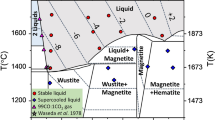Abstract
The effect of electric fields on the thermal dehydration of amorphous hydrated iron(III) oxide under oxidizing, inert and reducing atmospheres was studied by X-ray diffractometry. In oxidizing and inert atmospheres, the transformation toα-Fe2O3 was enhanced by electric fields, especially at the negative electrode. The crystallite size of the product was also greatest at the negative electrode. Both results are explained in terms of the migration of protons to the negative electrode, where they subsequently form water which acts as a nucleating agent for the crystalline phase. In reducing atmospheres the formation of Fe3O4 and FeO at the expense of Fe2O3 is facilitated by electric fields, particularly at the negative electrode. Possible reaction mechanisms are considered, and the role of protons in stabilizing defect-spinel intermediates and products is discussed.
Résumé
L'effet d'un champ électrique sur la déshydratation thermique de l'oxyde de fer(III) hydraté amorphe a été étudié par diffractométrie des rayons X, dans des atmosphères oxydante, inerte et réductrice. En atmosphères oxydante et inerte, le champ électrique facilite la transformation en α-Fe2O3, en particulier à l'électrode négative. La taille des cristaux formés est également plus élevée à l'électrode négative où il se forme de l'eau qui agit comme agent de nucléation de la phase cristalline. En atmosphère réductrice, le champ électrique facilite la formation de Fe3O4 et FeO, aux dépens de Fe2O3, en particulier à l'électrode négative. On considère les mécanismes de réaction possibles et on discute le rôle des protons sur la stabilisation des produits et des intermédiaires défauts-spinelles.
Zusammenfassung
Der Einfluß eines elektrischen Feldes auf die thermische Dehydratisierung des amorphen hydratisierten Eisen(III)oxids in oxidierenden, inerten und reduzierenden Atmosphären wurde durch Röntgendiffraktometrie untersucht. In oxidierenden und inerten Atmosphären wurde die Umwandlung zu α-Fe2O3 durch elektrische Felder gefördert, besonders an der negativen Elektrode. Die Form der Kristallite des Produkts war ebenfalls an der negativen Elektrode am größten. Beide Ergebnisse werden durch die Proteinwanderung zur negativen Elektrode erklärt, wo diese Wasser bilden, das für die kristalline Phase als Keimbildner fungiert. In reduzierenden Atmosphären wird die Bildung von Fe3O4 und FeO auf Kosten von Fe2O3 durch elektrische Felder besonders an der negativen Elektrode erleichtert. Mögliche Reaktionsmechanismen werden erörtert und die Rolle der Protonen bei der Stabilisierung defekt-spineller Zwischenstufen und Produkte besprochen.
Резюме
С помощью рентгено-ди ффрактометрии изуче но влияние электрическ ого поля на термическую дегид ратацию гидроокиси ж елеза(III) в окислительной, инерт ной и восстановитель ной атмосфере как среде. В окислительной и инер тной атмосферах превраще ние до α-Fe2O3 увеличивалось электрическим полем, особенно на отрицательном эле ктроде, Размеры кристаллито в этого продукта были наибольшими также на отрицательн ом электроде. Оба результата были о бъяснены на основе ми грации протонов к отрицател ьному электроду, где они впо следствии образуют в оду, которая действует как криста ллизационное средство для кристал лической фазы. В восстановительной а тмосфере образовани е Fe3O4 и FeO за счет Fe2O3 облегча ется электрическим п олем и особенно на отрицат ельном электроде. Рассмотре н возможный механизм реакций и обсуждена роль прото нов в стабилизации промежуточных проду ктов с дефектной шпин ельной структурой, а также ко нечных продуктов.
Similar content being viewed by others
References
K. J. D. MacKenzie, J. Thermal Anal., 5 (1973) 5.
K. J. D. MacKenzie, J. Thermal Anal., 5 (1973) 19.
K. J. D. MacKenzie, Thermochim. Acta, 16 (1976) 1.
G. F. Huttig andH. Garside, Z. Anorg. Chem., 179 (1929) 49.
E. Ya. Rode, Zh. Russ. Fiz. Khim. Obshch., 62 (1930) 1443.
L. G. Berg, K. P. Pribylov, V. P. Egunov andR. A. Abdurakmanov, Russ. J. Inorg. Chem., 14 (1969) 1211.
E. P. Tsymbal, S. I. Smyshlyaev andL. M. Dvornikova, Russ. J. Inorg. Chem., 15 (1970) 1635.
K. J. D. MacKenzie, Trans. J. Brit. Ceram. Soc., 74 (1975) 121.
K. J. D. MacKenzie andP. J. Melling, Thermochim. Acta, 9 (1974) 389.
I. F. Guilliatt andN. H. Brett, J. Brit. Ceram. Soc., 6 (1969) 56.
K. J. D. MacKenzie, R. Smits andP. J. Melling, Trans. J. Brit. Ceram. Soc., 73 (1974) 185.
F. A. Cotton andG. Wilkinson, Advanced Inorganic Chemistry, Interscience, N. Y., 1962, p. 270.
K. J. D. MacKenzie, Trans. J. Brit. Ceram. Soc., 72 (1973) 209.
Author information
Authors and Affiliations
Additional information
The author is indebted to P. J. Melling for assistance with the measurements in H2/N2 atmospheres.
Rights and permissions
About this article
Cite this article
MacKenzie, K.J.D. Thermal reactions of inorganic hydroxy-compounds under applied electric fields. Journal of Thermal Analysis 16, 487–498 (1979). https://doi.org/10.1007/BF01910712
Received:
Issue Date:
DOI: https://doi.org/10.1007/BF01910712




